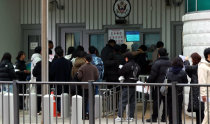Lees Biz-Friendly Policy Spurs Investment
Lees Biz-Friendly Policy Spurs Investment
Posted May. 19, 2008 07:55,
○ Conglomerates pop up new investment plans
Koreas second-largest refiner GS Caltex announced Friday that it would invest a total of almost 2.94 trillion won starting next month to build a heavy oil upgrading facility in Yeosu by 2010. The plant is expected to process 113,000 barrels a day.
The announcement caught most people by surprise, considering the companys huge loss of 23.2 billion won in the first quarter amid rising oil prices and exchange rates. The investment is the largest in size since the companys foundation as well as the largest made by a single Korean refiner.
Industry insiders say that the decision is based on the managements will to overcome the oil crisis by increasing facilities with high productivity.
Other Korean chaebol are following suit.
LG Display, for example, will put in 1 trillion won to upgrade its liquid crystal display plants in Gumi, North Gyeongsang Province, used mainly for the production of monitor panels. Earlier, SK Energy decided last month to arm its Incheon plant with cutting-edge technologies by investing 1.5 trillion won.
Likewise, Hyundai Heavy Industries held a ground-breaking ceremony earlier this month for its new Gunsan shipbuilding yard, with a projected 1.2-trillion-won investment. In addition, Samsung Electronics and Sony said last month that they will jointly invest some 1.8 trillion won to build an additional LCD 8-2 line in Tangjeong, South Chungcheong Province.
Hyundai Steel decided last month to expand its investment by 600 billion won to build a steel plant in Dangjin, South Chungcheong Province, notching up the total to 5.84 trillion won from 5.24 trillion won. This month, Samsung SDI, CJ Cheiljedang and LG Telecom all have announced their investment plans worth 100 billion won, each.
On April 30, LS Cable kicked off the construction of a 130-billion-won plant in Donghae, Gangwon Province, to produce underwater power cables.
○ Overall change in sentiment toward businesses lead to investment
Industry experts say that most companies had stocked up cash in their bank accounts under previous administrations. Now, they are getting warmed up for investment, encouraged by business-friendly policies of the new administration, which resulted in the restoration of entrepreneurship.
The Federation of Korean Industries (FKI) Executive Director Lee Seung-cheol said, I believe a couple of factors stimulated the new moves. First, the Lee administration has promised and embarked on overall deregulation, thereby offering various incentives for investment. Second, the corporate tax rates and industrial land prices have fallen, hinting at improved corporate profits. Finally, businesses themselves are trying to maintain and increase momentum for advancement by tapping on new projects.
A GS Caltex director, who requested anonymity, said, The company is evenly owned by GS and U.S. Chevron. When we want to make an investment, we need the consents from both of them. Chevron must have been motivated by the business-friendly policy of the new administration.
Local governments are also doing their part.
LS Cables plant in Gangwon Province and the new shipyard plan of Hyundai Heavy Industries set forth model examples highlighting the productive results of local entities business-friendly administration.
Furthermore, most companies that have announced new business initiatives are free of haggling labor disputes.
GS Caltex, for example, has not suffered any labor disputes since December 2005 when labor and management declared mutual harmony. Hyundai Heavy Industries have not seen a single dispute for 13 years in a row. Purchased by SK Group in March 2006, SK Incheon Oil has not undergone any labor disputes.
○ Outlook for continued investment
The latest move is yet to be observed before being defined as the mainstream trend.
Bad news and factors are still hovering over the Korean economy, including high prices of oil and industrial materials. According to the National Statistical Office, the increase in facility investment remained negative in the first two months of this year, and went up a meager 0.4 percent in March.
Still, rosy predictions are heard loud. They say that the sluggish trend is likely to turn up soon, and the momentum was not counted in the report.
Most investment plans that came out after the inauguration of the Lee administration will be put into practice in the later second quarter or during the last two quarters of this year. Thus, the first quarter statistics naturally failed to count them in.
Furthermore, the FKI found that the 30 largest Korean business groups would invest almost 95 trillion won in total this year, a 26 percent increase from last year, including Samsungs largest ever investment of 27.8 trillion won.






![노동신문 개방? 노동신문 서버는 개방을 견뎌낼까?[주성하의 ‘北토크’]](https://dimg.donga.com/c/138/175/90/1/wps/NEWS/IMAGE/2025/12/26/133032325.1.jpg)
